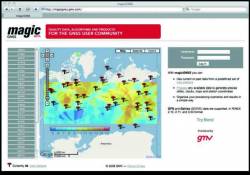As stated in these pages last September, every GNSS user in every segment can benefit from the new modernized signals in the L5 band. Foremost among these are likely to be smartphone users.
And who isn’t a smartphone user?
L5 signals are more accurate, more reliable, and are currently available in sufficient numbers, between 16 GPS satellites plus Galileo and BeiDou, to support all user segments.
L5 has several advantages over L1: signal structure, wide bandwidth, pilot codes, other GNSS signals with a common structure, stronger transmission, lower bit error rate and cross correlation, and a cleaner band.
“The use of L5 signals provides the capability of delivering 10x higher precision than a legacy L1 GNSS receiver in an open environment, as well as very noticeable benefits in multipath environments,” said Charlie Abraham, Broadcom Senior Director of Engineering for the Wireless Communications and Connectivity Division.
“Broadcom’s 2nd generation dual-frequency GNSS BCM47765 chip utilizes every available L5 signal in space, which totals over 80 signals, including the 30 new BeiDou3 B2a signals. When BCM47765 is combined with the 3D Building Model correction service from Google, the solution provides pedestrian users with sidewalk-level accuracy in urban canyons.”
That’s the magic. As cogently explained in our cover story, L5 and 3D mapping-aided GNSS go together “like bread and butter.” We leave it to Google, as we leave so much these days, to explain this further, on page 42.
“Google’s 3D mapping aided corrections are a major advancement in personal location accuracy for smartphone users when walking in urban environments,” said DeMarco Chou of MediaTek. “Our Dimensity 5G family enables 3D mapping aided corrections in addition to its highly accurate dual-band GNSS and dead reckoning performance to give the most accurate global positioning ever for 5G smartphone users.”
A second technical feature in this issue, “Catching a Ride: Improvements to Position Accuracy for eMobility Applications,” demonstrates why Lyft intends to build L5 capability into the rental scooters and e-bikes on which we can soon flutter around downtowns. So green, so green.
Chip manufacturers and telecomm companies are well out in front of the trends on this. They have to be.
“Qualcomm Technologies is leading the charge to improve consumer experiences with its newest Qualcomm Location Suite technology featuring support for dual L1/L5 frequencies, sensor-assisted positioning towards lane level and sidewalk accurate navigation—all of which we make available in our flagship portfolio of Snapdragon Mobile Platforms,” said Francesco Grilli, vice president of product management at Qualcomm Technologies, Inc.
To be sure, modern smartphones and mobile devices use a lot more than GNSS to achieve lane-level vehicular or sidewalk pedestrian accuracy. They employ network-based location and assistance, sensor assistance including dead-reckoning, and correction services that bring precision similar to that of RTK, which is not practical to implement in phones.
Finally, at a company devoted singlemindedly to that select new band, Greg Turetzky, VP Product at OneNav, volunteers “We are excited to see the performance improvement from our PureL5 GNSS System, which uses the entire 50MHz bandwidth of all the signals in the L5 band to produce rich measurement data. When combined with Google’s 3D building models, this will provide near meter-level accuracy in the urban canyons for mobile phones users and improve user experience in multiple applications.”
Although the L1 signal structure could be characterized as “outdated,” vulnerable to cross correlation, jamming and spoofing, it won’t go away anytime soon. Its installed base is too large, its use paths so well known and well worn. On the other hand, L1 could come to resemble, one of these days, black and white TV. Still around, still employed by some in some situations, but not, as they say, the leading brand.






